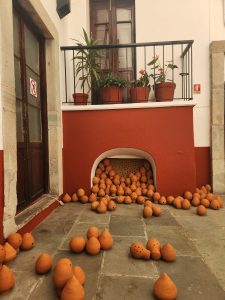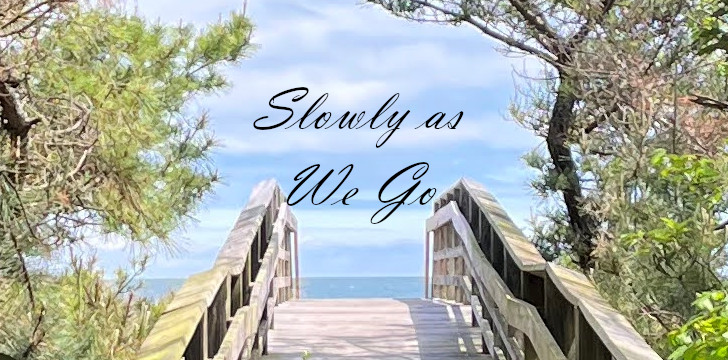We did not visit the mummy museum. I want to get that out of the way first, since it’s one of the biggest attractions in town. We both just felt a little weird about it.

El Cerro de la Bufa: This seems like the most popular local hike, based on my research before we arrived. Some reviewers said they walked to the trailhead from town, but we were staying on the other side of the valley and it would have added a lot of walking on busy roads for us, so we just took an Uber from our apartment. I’d recommend it, regardless of where you’re staying. The road leading to the trailhead didn’t seem like the most pedestrian friendly. The hike is a 5-mile, out-and-back trail that passes la Cueva de San Ignacio. The cave is early in the hike and has some Catholic statues but also seems like a hangout spot based on the trash and graffiti. Pop in to see what’s going on, but don’t expect much. After the cave, the trail gets a little steeper and there are a few scrambly bits, but we were rewarded with horses at the top! There were 2 groups each with about 4-6 horses, just chilling and eating grass at the top. The views of the valley were stunning from the top.


Alhondiga de Granaditas Regional Museum: This is the old grain storage and marketplace in Guanajuato. It was an important location in the revolution for Mexican independence and now is a regional history museum. The building itself is two stories wrapping around a large central courtyard with small rooms on both floors. Displays include precolombian art and artifacts from various cultures (Aztec, Maya, Occidente, Teotihuacana, Totonaca, Huasteca, Zapoteca); religious and secular works from colonial times; displays about the revolution and aftermath. My favorite parts were the overwhelming murals in the stairways. There is a small admission fee per person and an additional fee if you want to take photos.



Museo del Pueblo de Guanajuato: This was my favorite museum in Guanajuato. It’s in an old house with a small courtyard and has different art from the region in the varying rooms plus a chapel. When I visited, it included miniatures, a special exhibit of calaveras (skulls), an exhibit of Leonora Carrington’s surreal paintings and sculptures, and other treasures. The admission fee is $30 pesos.


Diego Rivera’s House Museo: This was Diego’s childhood home, so they have some displays of rooms with period-appropriate furniture, but it’s not stuff his family had or necessarily set up how they lived there. Most of the art is from Diego but you can’t photograph it. There are a few rooms with other people’s work as well, and a weird central courtyard that is all modern and not very inviting. The layout was very clear, until you get to the end and want to leave. (It’s back through the main entrance.) The admission fee is $30 pesos.
Kissing Alley: We visited the kissing alley but it was mobbed and we didn’t feel like waiting in line to pay to kiss each other, so we just kissed at the end of the line and kept moving.

El Pipila and the Funicular: This was the first thing we did in town, and it was worth the hype. Behind the Teatro Juarez downtown, you can take the funicular up the hillside and then walk to the monument to local revolutionary hero El Pipila. The massive statue is high up on the hill with a large terrace area with beautiful views of the city below. Because we were there a few weeks before Dia de Muertos, there was a guy dressed as Death at the top taking photos with people. We also walked to the little bar just down from the main lookout point for a michelada and more amazing views.


Ephrat Asherie: We saw a U.S. dance troupe that was performing as part of the Cervantino at the State Auditorium. It was a group of 6 to 8 dancers and a few musicians who got in on the dancing at times as well. We had to take an Uber to the auditorium, which was huge and sadly not even 1⁄4 full for the show. We weren’t allowed to take photos of the performance, but the venue itself was pretty cool. It was a large, brutalist-style building with pebble-covered interior walls. We tried to get tickets to other Cervantino shows in the Teatro Juarez and other venues in the centro, but we definitely should have booked way before we arrived in Guanajuato. Everything that was still available was hundreds of dollars per ticket.
Movies at the University of Guanajuato: As part of the Cervantino, there were movie screenings in a few different locations around town. I went to one in the university that was designed to highlight accessibility in film. They handed out eye masks for people to wear to experience “watching” a movie without sight. Unfortunately, my Spanish wasn’t good enough for me to follow along without reading the subtitles! They also had a woman at the front signing for hearing impaired audience members, in addition to the subtitles.

A few days later, Andrew and I saw a bit of Ma Rainey’s Black Bottom on the outside stairs of the University of Guanajuato. They set up a huge, inflatable screen and had people handing out free popcorn. It was really nice but we were in between plans and couldn’t stay for the full movie.


